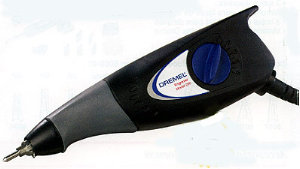 I purchased a Dremel engraver today (like the one shown on the left) with a versa-tip as discussed by the manufacturer:
I purchased a Dremel engraver today (like the one shown on the left) with a versa-tip as discussed by the manufacturer:The Dremel Engraver is ideal for identifying and personalizing your valuables as well as decorative engraving. At 7,200 strokes per minute, the 115 volt motor and carbide point do more than just scratch the surface. Stroke adjustment dial on tool regulates engraving depth, from fine lines to deep grooves. Get the performance you need to engrave on metal, plastic, glass, ceramic, wood and even leather.
This is the tool I will be using to engrave my athame as posted previously. It really has a nice grip too. Boy oh boy! the things I am going to engrave! My kiddush cup is scheduled for witchy personalization too. I have so many projects in my head - I hope I am good at this. I've never "literally" engraved before in my life.
Sefer Yetzirah (R' Aryeh Kaplan translation) 1:1 teaches about engraving:
The Creator used (these) 32 paths to "engrave" so as to create His universe. The Hebrew word here is chakak (חקק). This usually has the connotation of removing material, as in the verse, "Engrave (chakak) yourself a dwelling in a rock" (Yishayahu 22:16). Derived from this root are the words chok (חוק) and chukah (חוקה), meaning "rule" and "decree", since rules and laws serve to remove some of the individual's freedom of action. Thus, the word chakak is closely related to ma-chak (מחק), meaning "to erase" as well as to the root la-kach (לקח), meaning "to remove" or "take" [1].
The word chakak is very closely related to the concept of writing. The main difference between engraving (chakak) and writing is that when one writes, one adds material such as ink to the writing surface, while when one engraves, one removes material. When the Bible uses the word chakak to designate writing, it is referring to such systems as cuneiform, where the text was written by removing wedges of clay from a tablet.
To understand why the author uses the term "engraved" here, we must understand the idea of creation. Before a universe could be created, empty space had to exist in which it could be made. But initially, only G-d existed, and all existence was filled with the Divine Essence, the Light of the Infinite (Aur Ein Sof). It was out of this undifferentiated Essence that a Vacated Space had to be engraved. The process, known to the kabbalists as the tzimtzum (constriction), is clearly described in the Zohar:
In the beginning of the King's authority
The Lamp of Darkness
Engraved a hollow in the Supernal Luminescence ...
The hollow engraved in the Supernal Luminescence was the Vacated Space, in which all creation subsequently occurred.
The undifferentiated Light of the Infinite which existed before the constriction is on the level of Chochmah (Wisdom), which is pure undelineated Mind. The power of constriction is that of Binah (Understanding), this being what the Zohar calls the Lamp of Darkness. It is negative Light, or negative existence, which can engrave a hollow in the Divine Essence.
Thus, my engraving endeavors begin.
A witch's brew:
Footnote:
[1] The root la-kach (לקח) also means "receiving" (like mekubal), "learning", "assuming a right to oneself", "knowledge", and "tongs". Etymological Dictionary Of Biblical Hebrew, R' Matityahu Clark (p. 133).
original tongs, for tongs must be made with tongs ...
Pirkei Avot 5:6

No comments:
Post a Comment